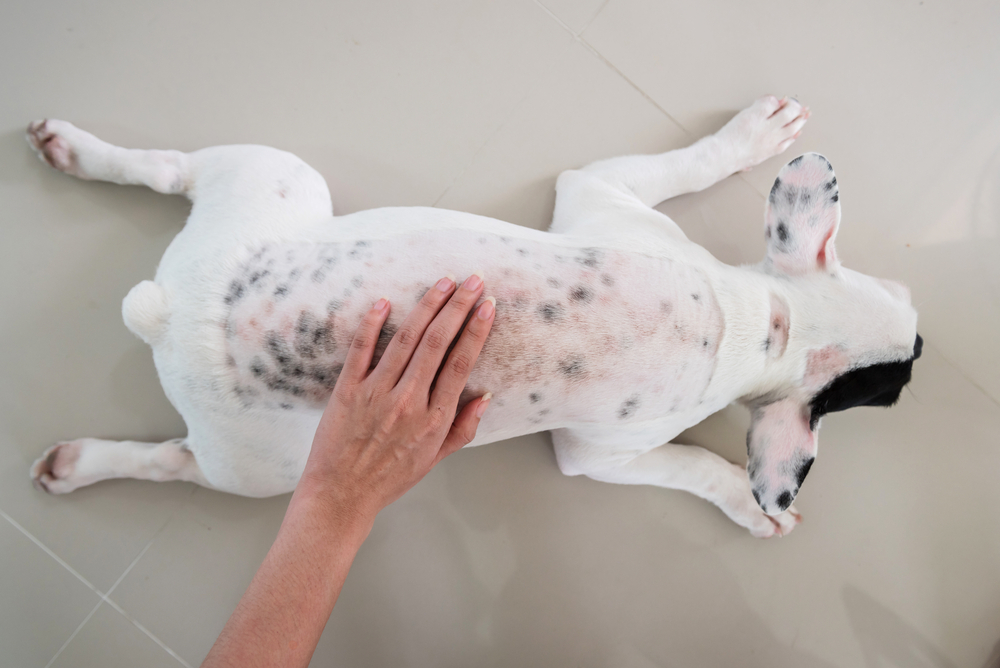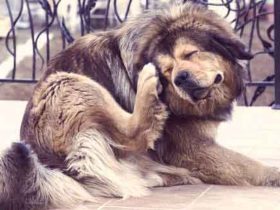Apply coconut oil to your dog’s skin and ensure proper hydration. Use a humidifier to add moisture to the air.
Dry skin in dogs can cause discomfort and lead to more serious health issues. Identifying the root cause is crucial for effective treatment. Common reasons include allergies, poor diet, and environmental factors. Regular grooming helps maintain healthy skin and coat.
Adding fatty acids to their diet can improve skin hydration. Consulting a veterinarian ensures proper diagnosis and treatment. Natural remedies like oatmeal baths can soothe irritated skin. Avoid harsh chemicals in grooming products. Keeping your dog hydrated is essential. Proper care and attention can significantly improve your dog’s skin health.
Identifying Dry Skin
Dry skin can cause discomfort for your dog. Identifying dry skin early helps in treating it effectively. Learn to recognize the signs and causes to keep your dog healthy and happy.
Common Symptoms
Look out for the following common symptoms of dry skin in dogs:
- Flaking or dandruff
- Redness or irritation
- Itching and scratching
- Excessive licking
- Patchy fur loss
- Scabs or crusts
Causes Of Dry Skin
Several factors can cause dry skin in dogs. Here are some common causes:
- Allergies to food or environment
- Parasites like fleas or mites
- Infections bacterial or fungal
- Weather changes, especially cold and dry air
- Poor diet lacking essential nutrients
- Frequent bathing with harsh shampoos
Understanding these causes can help you prevent and treat your dog’s dry skin. Consult your vet if you notice these symptoms or have concerns.

Credit: www.ovrs.com
Dietary Changes
Changing your dog’s diet can help improve dry skin. Proper nutrition can keep their skin healthy and hydrated.
Nutrient-rich Foods
Feeding your dog nutrient-rich foods can improve their skin health. These foods contain essential vitamins and minerals.
Include foods rich in:
- Vitamins A, E, and C
- Zinc
- Biotin
These nutrients support skin health and hydration. Fresh fruits and vegetables are great sources.
Omega-3 Fatty Acids
Omega-3 fatty acids are vital for healthy skin. They reduce inflammation and dryness.
Sources of omega-3 fatty acids include:
- Fish oil
- Flaxseed oil
- Chia seeds
Consider adding these to your dog’s diet. They help keep the skin smooth and moist.
| Food | Key Nutrients |
|---|---|
| Carrots | Vitamin A |
| Sweet Potatoes | Vitamin E |
| Blueberries | Vitamin C |
| Pumpkin | Zinc |
| Eggs | Biotin |
Adding these foods can help improve your dog’s skin health. Always consult your vet before making any dietary changes.
Hydration Tips
Dry skin can make your dog uncomfortable. Proper hydration is crucial to solve this issue. This section explores effective hydration tips.
Water Intake
Ensuring your dog drinks enough water is essential. Dogs need water to keep their skin hydrated. Provide fresh water daily. Check their water bowl often. Clean the bowl regularly to prevent bacteria.
Consider using a water fountain. Moving water can encourage dogs to drink more. Keep an eye on your dog’s water intake. If they drink less, it could indicate a health issue.
Moisturizing Treats
Some treats can help moisturize your dog’s skin. Look for treats containing omega-3 fatty acids. These can boost skin health. Fish oil treats are a great option. They can reduce dryness and itching.
| Treat Type | Benefits |
|---|---|
| Fish Oil Treats | Contains omega-3, reduces dryness |
| Flaxseed Treats | Rich in fatty acids, boosts skin health |
| Sweet Potato Treats | Natural moisturizer, easy to digest |
Homemade treats can also help. Try making treats with ingredients like coconut oil. It’s a natural moisturizer. Mix a small amount into your dog’s food.
Avoid treats with artificial additives. These can worsen dry skin. Always check the ingredient list before buying.
Bathing Practices
Bathing practices play a crucial role in managing your dog’s dry skin. Proper bathing can help soothe irritation and maintain healthy skin. Below are some key practices to follow.
Gentle Shampoos
Choose a gentle shampoo designed for dogs with dry skin. Look for products free from harsh chemicals and artificial fragrances. Ingredients like oatmeal and aloe vera are beneficial. They help moisturize and soothe the skin.
Avoid human shampoos as they can disrupt your dog’s skin pH balance. Always read the label before purchasing. If unsure, consult your vet for recommendations.
Bath Frequency
Bathing your dog too often can worsen dry skin. Aim for a bath once every 4-6 weeks. This frequency helps maintain natural oils in the skin.
If your dog gets dirty often, use wipes or a damp cloth for spot cleaning. This method avoids stripping essential oils from their coat.
| Bath Frequency | Reason |
|---|---|
| Every 4-6 weeks | Maintains natural skin oils |
| Spot Cleaning | Prevents oil stripping |
Follow these bathing practices to help your dog’s dry skin. Remember, gentle care is key.
Environmental Factors
Environmental factors can greatly impact your dog’s skin health. These factors include indoor humidity levels and allergens. Addressing these can help improve your dog’s dry skin.
Indoor Humidity
Low indoor humidity can dry out your dog’s skin. Use a humidifier to add moisture to the air. Aim for a humidity level between 40% and 60%. This range keeps your dog’s skin hydrated.
Place the humidifier near your dog’s resting area. Ensure it’s cleaned regularly to avoid mold growth. A clean humidifier provides the best results for your dog’s skin.
Allergen Control
Allergens can cause skin irritation in dogs. Common allergens include pollen, dust mites, and mold. Keeping your home clean reduces the presence of these allergens.
- Vacuum your home frequently.
- Wash your dog’s bedding every week.
- Use air purifiers to remove airborne allergens.
Consider allergy-friendly cleaning products. These products can be less irritating to your dog’s skin.
Regular grooming also helps. Brush your dog to remove loose fur and allergens. Bathing with hypoallergenic shampoo can soothe dry skin.
| Environmental Factor | Action |
|---|---|
| Indoor Humidity | Use a humidifier |
| Allergens | Vacuum and clean bedding |
:max_bytes(150000):strip_icc()/puppy-bath-181181865-2000-9cf1cb59df934605b536a31cc48ff9e4.jpg)
Credit: www.dailypaws.com
Topical Treatments
Dogs with dry skin need special care. Topical treatments help soothe and heal their skin. Let’s explore some effective solutions.
Natural Oils
Natural oils are safe and effective for dry dog skin. They moisturize and nourish the skin naturally.
- Coconut Oil: Coconut oil hydrates and soothes dry skin. Apply a small amount to the affected area.
- Olive Oil: Olive oil is rich in vitamins. It helps heal and moisturize dry patches.
- Vitamin E Oil: Vitamin E oil promotes skin health. Rub a few drops on your dog’s dry spots.
Medicated Products
Medicated products can treat severe dry skin in dogs. These products contain active ingredients that target specific skin issues.
| Product | Benefits |
|---|---|
| Anti-Itch Sprays | Reduce itching and inflammation. Provide quick relief. |
| Hydrocortisone Creams | Reduce swelling and redness. Effective for hot spots. |
| Antibacterial Shampoos | Clean and protect the skin. Prevent infections. |
Always check with your vet before using medicated products. They can recommend the best treatment for your dog’s specific condition.
Regular Grooming
Regular grooming can help keep your dog’s skin healthy. It removes dead skin cells and distributes natural oils. This process can prevent dry skin issues in dogs. Let’s explore the best techniques and tools.
Brushing Techniques
Brushing your dog’s coat is essential. It helps remove dirt and loose hair. Use gentle strokes to avoid hurting your dog. Brush in the direction of the hair growth.
Here are some brushing techniques to follow:
- Start with a wide-toothed comb for tangles.
- Use a bristle brush for short-haired breeds.
- For long-haired dogs, use a slicker brush.
Brushing also helps spread natural oils. These oils keep your dog’s skin moist. Regular brushing can reduce dry skin problems.
Skin-friendly Tools
Using the right tools makes a big difference. Some tools are better for your dog’s skin. Look for tools that are gentle and effective.
Here is a table of skin-friendly tools:
| Tool | Best For |
|---|---|
| Wide-Toothed Comb | Tangling and matting |
| Bristle Brush | Short-haired breeds |
| Slicker Brush | Long-haired breeds |
| Rubber Brush | Bath time and massaging |
A rubber brush is great for bath time. It can also massage your dog’s skin. This helps improve blood circulation and skin health.
Use these tools correctly to avoid skin irritation. Keep your tools clean to prevent infections. Regular grooming with the right tools can help your dog’s dry skin.

Credit: www.doglyness.com
When To See A Vet
Seeing your dog struggle with dry skin can be stressful. Sometimes, home remedies just aren’t enough. Knowing when to visit the vet is crucial for your dog’s health.
Persistent Symptoms
If your dog’s dry skin persists after trying home treatments, it’s time to see a vet. Redness, constant itching, and flaking are warning signs. These symptoms might point to a deeper issue.
Use this table to track persistent symptoms:
| Symptom | Duration |
|---|---|
| Redness | More than 2 weeks |
| Itching | Doesn’t stop |
| Flaking | More than 1 week |
Underlying Conditions
Dry skin might be a sign of underlying conditions. These could include allergies, infections, or hormonal imbalances. A vet can diagnose and treat these issues.
Here are some common conditions:
- Allergies: Food or environmental triggers.
- Infections: Bacterial or fungal.
- Hormonal Imbalances: Hypothyroidism or Cushing’s disease.
Only a vet can properly diagnose these conditions. Early detection leads to better treatment outcomes.
Frequently Asked Questions
What Causes Dry Skin In Dogs?
Dry skin in dogs can be caused by allergies, poor diet, or environmental factors. It can also result from parasites or underlying health conditions.
How Can I Moisturize My Dog’s Dry Skin?
Use a vet-approved moisturizer or coconut oil. Regularly bathe your dog with hypoallergenic shampoo to keep their skin hydrated.
Are There Any Home Remedies For Dog Dry Skin?
Yes, oatmeal baths, coconut oil, and fish oil supplements can help. Ensure a balanced diet rich in omega-3 fatty acids.
Can Diet Affect My Dog’s Skin Health?
Absolutely, a poor diet lacking essential nutrients can lead to dry skin. Ensure your dog’s food is well-balanced and nutrient-rich.
Conclusion
Helping your dog’s dry skin is essential for their comfort and health. Regular grooming, proper diet, and hydration are key. Use moisturizing shampoos and consult your vet for persistent issues. By following these tips, you can ensure your dog’s skin stays healthy and itch-free.
A happy dog means a happy home.







